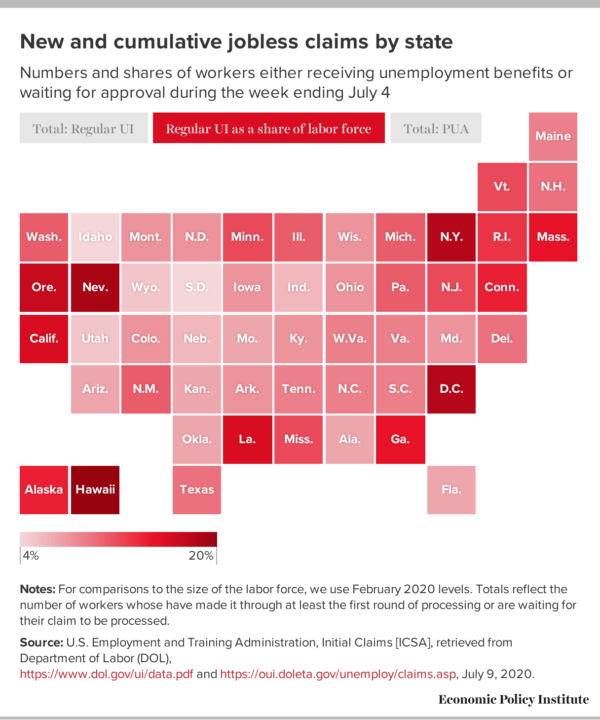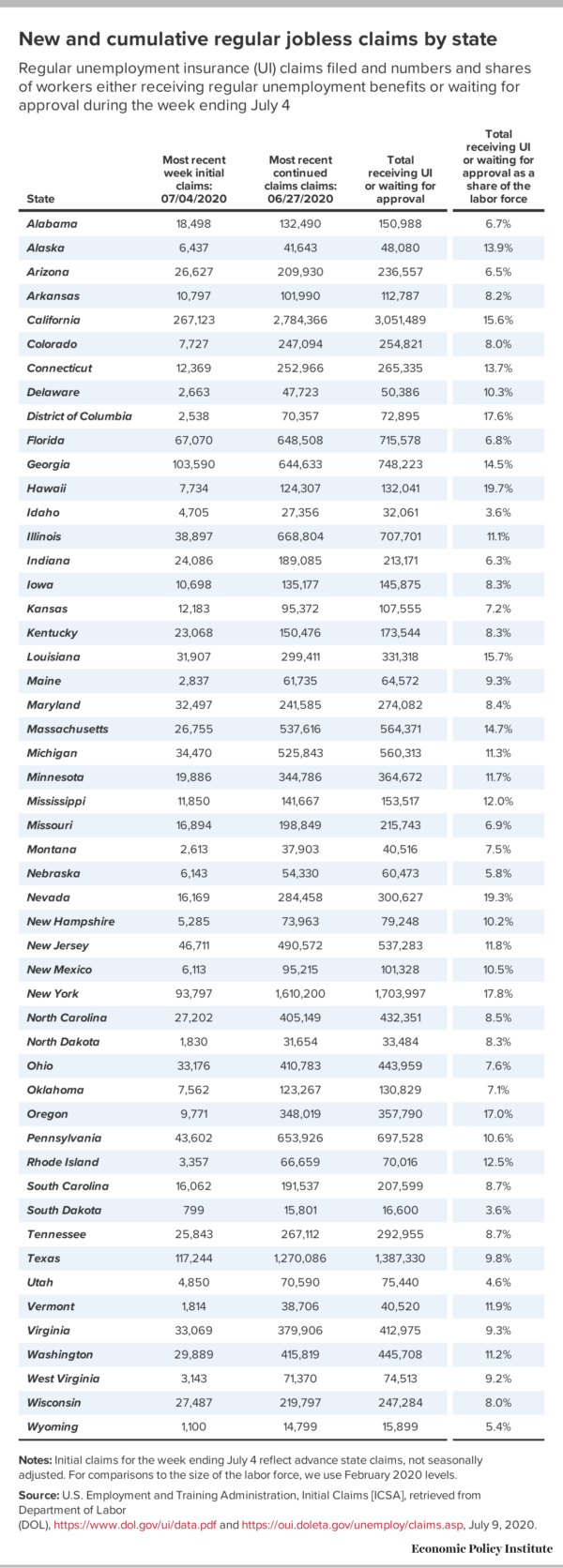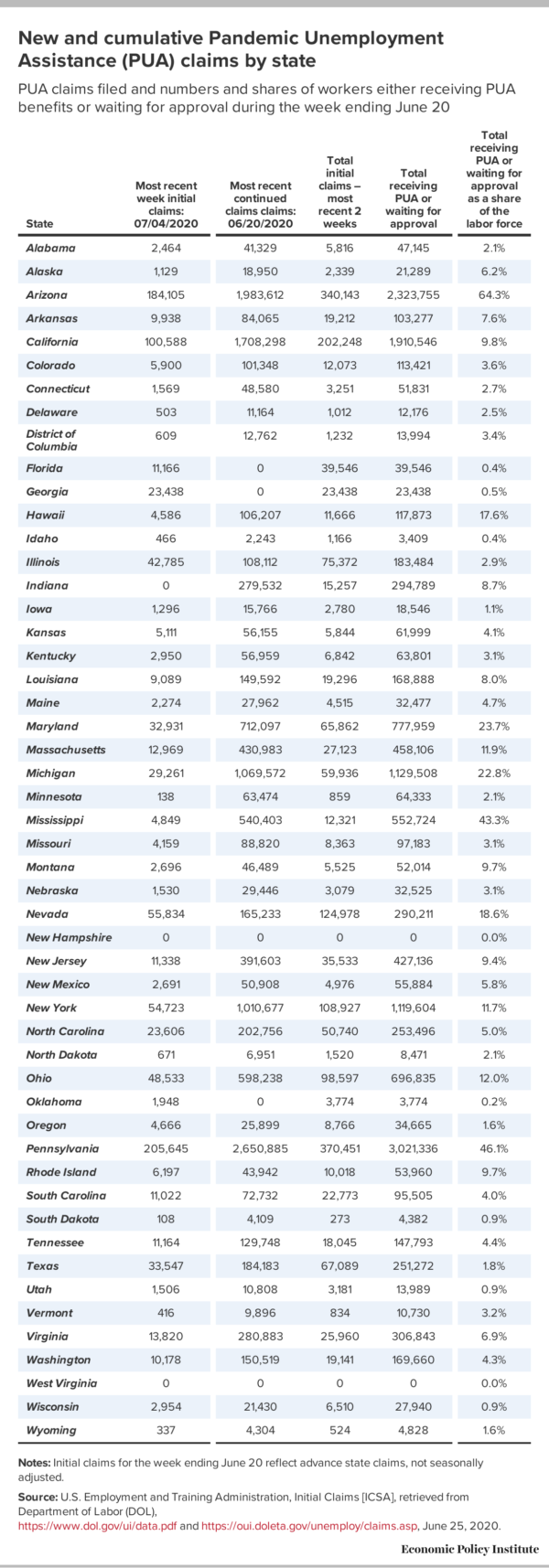https://www.epi.org/blog/extending-the-600-weekly-unemployment-boost-would-support-millions-of-workers-see-updated-state-unemployment-data/
The U.S. Department of Labor (DOL) released the most recent unemployment insurance (UI) claims data yesterday, showing that another 1.4 million people filed for regular UI benefits last week (not seasonally adjusted) and 1.0 million for Pandemic Unemployment Assistance (PUA), the new program for workers who aren't eligible for regular UI, such as gig workers. As of last week, more than 35 million people in the workforce are either receiving or have recently applied for unemployment benefits—regular or PUA.
Figure A and Table 1 show the total number of workers who either made it through at least the first round of regular state UI processing as of June 27 (these are known as "continued" claims) or filed initial regular UI claims during the week ending July 4. Three states had more than one million workers either receiving regular UI benefits or waiting for their claim to be approved: California (3.1 million), New York (1.7 million), and Texas (1.4 million). Seven additional states had more than half a million workers receiving or awaiting benefits.
While the largest U.S. states unsurprisingly have the highest numbers of UI claimants, some smaller states have larger shares of the workforce filing for unemployment. Figure A and Table 1 also show the numbers of workers in each state who are receiving or waiting for regular UI benefits as a share of the pre-pandemic labor force in February 2020. In four states and the District of Columbia, more than one in six workers are receiving regular UI benefits or waiting on their claim to be approved: Hawaii (19.7%), Nevada (19.3%), New York (17.8%), District of Columbia (17.6%), and Oregon (17.0%).

Figure A and Table 2 show the total number of workers who either made it through at least the first round of PUA processing—the new federal program that extends unemployment compensation to workers who are not eligible for regular UI but are out of work due to the pandemic—by June 20 or filed initial PUA claims during the weeks of June 27 or July 4. We do not sum the PUA claims with regular UI claims because some states have misreported PUA claims in their initial claims data, leading to potential double counting.1
As of last week, DOL reported that over 15 million workers across 48 states and the District of Columbia are receiving or waiting on a decision for PUA benefits, which underscores the importance of extending benefits to those who would otherwise not have been eligible. Five states have at least a million workers in this category: Pennsylvania (3.0 million), Arizona (2.3 million), California (1.9 million), Michigan (1.1 million), and New York (1.1 million). New Hampshire and West Virginia still have not reported any PUA claims. Florida, Georgia, and Oklahoma have reported initial PUA claims, but have yet to report any continuing claims.
We should despair for the millions who have lost their jobs and for their families, and our top priority as a country should be protecting the health and safety of workers and our broader communities by paying workers to stay home when possible, whether that means working from home some or all of the time, using paid leave, or claiming UI benefits. When workers are providing absolutely essential services, they must have access to adequate personal protective equipment (PPE) and paid sick leave. The current spike in coronavirus cases across the country—and subsequent re-shuttering of certain businesses—show the devastating costs of reopening the economy prematurely.
As we look at the aggregate measures of economic harm, it is also important to remember that this recession is deepening racial inequalities. Black communities are suffering more from this pandemic—both physically and economically—as a result of, and in addition to, systemic racism and violence. Both Black and Hispanic workers are more likely than white workers to be worried about exposure to the coronavirus at work and bringing it home to their families. These communities, and Black women in particular, should be centered in policy solutions.
To mitigate the economic harm to workers, Congress should extend the across-the-board $600 increase in weekly unemployment benefits well past its expiration at the end of July. If Congress does not extend these benefits through next year, it could cost us more than 5 million jobs and $500 million in personal income. Figure B, at the end of this post, shows these expected job losses by state.
As part of the next federal relief and recovery package, Congress should also include worker protections, investments in our democracy, and resources for coronavirus testing and contact tracing (which is necessary to reopen the economy). At the same time, policymakers should prioritize long-overdue overhauls of federal labor law and continue to strengthen wage standards that protect workers and help boost consumer demand.
The package should also include substantial aid to state and local governments so that they can invest in the services that will allow the economy to recover, particularly public health and education. Without this aid, a prolonged depression is inevitable, especially if state and local governments make the same budget and employment cuts that slowed the recovery after the Great Recession. More than five million workers would likely lose their jobs by the end of 2021, harming women and Black workers in particular since they are disproportionately likely to work for state and local governments.


1. Unless otherwise noted, the numbers in this blog post are the ones reported by the U.S. Department of Labor (DOL), which they receive from the state agencies that administer UI. While DOL is asking states to report regular UI claims and PUA claims separately, many states are also including some or all PUA claimants in their reported regular UI claims. As state agencies work to get these new programs up and running, there will likely continue to be some misreporting. Since the number of UI claims is one of the most up-to-date measures of labor market weakness and access to benefits, we will still be analyzing it regularly as reported by DOL, but we ask that you keep these caveats in mind when interpreting the data.
Enjoyed this post? Sign up for the Economic Policy Institute's newsletter so you never miss our research and insights on ways to make the economy work better for everyone.
-- via my feedly newsfeed

No comments:
Post a Comment